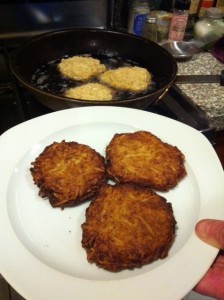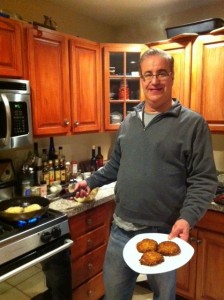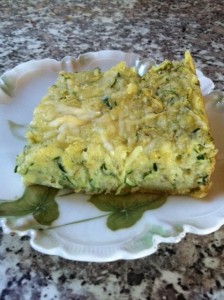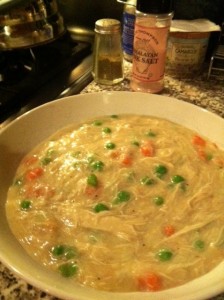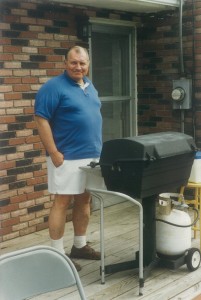On Sept. 28, my father left us. Peacefully, in his nursing home bed, surrounded by Love. He was in that bed for more than nine years, and afflicted with Alzheimer’s disease for 13. Given the circumstances, it might come as a surprise when I say I’m devastated by the loss. Logically, I realize that we lose our parents. The fact that it’s a natural part of life doesn’t make it any less painful when their death happens, even if it is a merciful end to a lingering illness. My Father and I were extremely close. We dieted together, overate together, struggled with low-self esteem together because of our size. He saw me regain 100 pounds twice. Watching me spiral down a second time was brutal on my Father because he always wanted me to be free. It tears at my heart that he didn’t get to experience the joys of my new, transformed self with me.
I’ve been mourning him for nine years, but now that he’s fully gone, the finality of it hurts. I know the sting of loss won’t always be as sharp as it is right now. Sometimes I think of him with a laugh. Other times I tear up when I see his framed smile across the room. The truth is, you’re never really ready to stop being with someone you deeply Love, seeing their face, hearing them laugh. Facts-of-life logic only go so far at times like these. The Heart has a far different interpretation. And I’ve been listening, because it’s the only way through the forest.
What has this to do with weight loss, fitness, and healthy living? Absolutely everything. File this under the ‘how to cope with the emotional triggers that could drive you back to the La-La Land of trance eating’ category. I don’t want to return La-La Land. For years, binge-eating is how I coped with my feelings of sadness over slowly losing my Father. All it got me was more buried in the muck of unfelt feelings and extra weight. I was slower, heavier, and my senses almost completely dulled. Getting comfort and relief from binge-eating is an illusion. It never took away any pain or solved any problem, it only distracted me from an issue, and then compounded it.
So here I sit today at the computer, throat a little achy from crying, as I listen to the beautiful chords of Johann Pachelbel’s ‘Nocturne,’ as arranged by Michael Maxwell. It sounds like the music angels would play, and it was Maxwell’s “The Elegance of Pachelbel” CD that filled the nursing home room during my Father’s passing. I’m committed to feeling this stuff, whatever comes along with the process of grieving. I want to remain as whole and as alive as possible.
And I’m also committed to honoring my Father’s memory and the imprints he left on so many during his time on Earth. So here he is, captured in an essay I wrote for his memorial service on October 2. He’s a pretty cool guy:
It was 1982, the year I was a high school senior. A classmate had just pulled into my driveway to pick me up for a shopping expedition at the mall. As I slid into the passenger seat, I saw her looking toward the house. “Look,” she said with a smile “There’s your father.” I hadn’t noticed, but after saying a quick good-bye to him at his home office, he must have quietly slipped outside to the back porch to watch us pull away. He stood in that feet-firmly-planted stance, jingling change in his pockets, smiling at us like a benevolent apparition on the elevated deck. I shook my head and probably rolled my eyes in mock frustration. “He’s always gotta oversee every detail,” I murmured, noticing that my friend looked both intrigued and a little wistful as she gazed at him. “Well, you’re lucky,” she said, as she backed out of our driveway. “I wish my father paid attention to me like that.”
Rapt attention. It’s what my father gave anything or anyone he felt passionate about, or even a little interested in, whether he was cheering Ronald Reagan in a presidential debate, visiting with a van full of newly arrived Timlo campers, or keeping vigil over a teflon pot full of Snow’s Clam Chowder, heating it to just under a simmer so the milk wouldn’t burn. Whether you were a niece or a nephew, his favorite pharmacist, a family friend, or the paper boy, if my Father was fond of you, you would be showered in a zany, effervescent kind of love that left you feeling enveloped in affection.
My Father had many passions in life, and like a multi-faceted jewel, just as many sides to him:
He was the chronic dieter who could steel his determination to exist on poached chicken breasts and bottles of Tab…and the carnivore whose idea of a perfect meal was Prime Rib and Mashed Potatoes at The Montcalm.
He was the Ivy League graduate who came home from church on Sundays to watch the body-slamming shenanigans of Chief Jay Strongbow and Andre The Giant during the weekly pro-wrestling matches on television.
My father had a home office, but loved being on the open road, and had an innate gift for navigating it. Whether it was Baltimore, Miami, or his beloved Pittsburgh, my Father effortlessly made his way through and around frenetic beltways and poorly marked highways like a homing pidgeon in the days when mapquest and GPS devices didn’t exist.
His unquenchable thirst for current events was well-documented, and began with morning newspaper headlines, followed by Paul Harvey at noon, and Walter Chronkite at 6:30 p.m. Before bed each night, he’d sit at the kitchen table paring the skin off a whole grapefruit into a perfect coil while Ted Koppel interviewed the latest embroiled heads of state.
My Father was also the perfectionist who liked things just so, such as his morning routine of black coffee poured to the brim of two white ceramic cups, the contents of which he didn’t touch until they cooled for 10 minutes. Then he’d gulp them down back-to-back and begin his day.
And probably the most amusing side to him: the unapologetic germaphobe who traveled with cans of Lysol in his trunk and would politely but unmistakably back a few paces away if you sneezed in his presence.
About halfway through writing this, I came to the conclusion that the floodgates of memory had been flung wide open upon my father’s passing, and was overwhelmed with the sheer volume of anecdotes, all of which reflected a different glimmering surface of the jewel. He was that colorful and that memorable a man. So I had to narrow it down to a single episode in the 48 years I had with him that summarizes the quality I appreciate most: Compassion.
True to his contradictory nature, my father was a caring man, but found it almost impossible to show it in the form of touchy-feely vocabulary or physical affection. Instead, he called on his masterful powers of intellectual oration when someone was in distress. The way he did on that bleak Saturday morning in the spring of 1980 when I woke to the news that our elderly German Shepherd, Duchess, was suddenly failing, and the time had come for that final visit to the vet. Her death left a particularly deep wound in me. Duchess came into my life when I was two, before Dory, Mike, and Jeff were born. She was a tiny bundle of fur when my Father brought her home in late September, 1966, an anniversary gift for my mother, because he wanted a watch dog to protect the home for the times he was away on business travel. For 14 years, Duchess silently trailed me like a guardian angel, and her unexpected departure from our lives that weekend left me too distraught to contemplate writing an essay on Dickens’ “A Tale of Two Cities,” that was due Monday. Ever the resourceful networker, he tracked my teacher down on Sunday, phoning her at home to explain the situation. He knew English was my favorite subject and it was unlike me not to delve into a reading assignment. I could hear him through the wall of his office, gently but persuasively making a case for a week’s clemency to finish the paper, bolstering his point with a brief outline of why Duchess was no ordinary canine to me or the rest of the family. As a first-time conversation with Barr Morris often went, his chat with Mrs. Davies eventually veered off the original subject and soon they were talking like an old friends.
Whether an incident was big or small, my Father couldn’t tolerate people hurting. He may not have been comfortable doling out hugs, but if one of us scraped our knee playing outside, he scrambled to the medicine cabinet for the box of Band-Aids and bottle of merthiolate. “This is going to sting a moment,” he announced before dabbing the wound with the flourescent pink disinfectant. “But I’ll blow on it to make it better.” I don’t know if it was the cool jet stream of air or his TLC, but the stinging stopped in its tracks each time. And if he knew that a neighborhood kid was being ostracized or picked on, my Father would call a meeting with his us to brainstorm ideas on how we could make the unfortunate one feel better.
He was also a loving Husband, whose tendency to procrastinate never deterred him from coming home on the evening of my Mother’s birthday or anniversary with an armful of gifts and a romantic card. As some of you know, my Father left us just a day before their 50th wedding anniversary. It had been years since we’d heard my Father’s voice, and I can only guess that, had he been able to express it, he would have had so many things to say to my Mother on the eve of their Golden milestone. Even had it been the old Barr, able to captivate with his melodic speaking voice overlaid with the most carefully chosen and elegant vocabulary, I doubt he would have found the proper words to express his awe and admiration to Margy for her devotion: nine solid years of visits to his room at The Pines, sometimes twice a day.
A few days ago, as we sat across from each other at his bedside, I asked my Mother what it felt like to be in possession of an E-Z Pass through the Gates of St. Peter. She just smiled and stroked his arm, saying she’s done nothing heroic. Loving and caring for my Father in sickness was never a question or a chore to my Mother. Theirs was a bond that lasted through some significant tribulations, even the more minor of which would likely vaporize many of today’s short-term marriages. And last week, my Father’s days were filled with turbo-charged doses of Love from his family, a few close friends who came to say good-bye, an avalanche of prayers from near and far, and from the wonderful nurses at The Pines, all of whom had tears in their eyes when they stopped at his bed to check on him, even if it wasn’t their shift.
Friends reminded me over the years that it’s vital to remember my father as the man he really was. So I like to picture him presiding over the grill on our deck, wearing his red “Hail To The Chef” apron as he oversees the charring of steaks for dinner. I can see him coming off the tennis court, his face beaded with sweat as he wipes his brow and gulps a paper cup of ice water. Or standing next to me on the shores of Lake George, peering through the thick lenses of his navy binoculars to see if the sailboat in the distance is a Rainbow or a Star.
These past few months, it was clear my Father’s time was approaching. That knowledge caused me to do things like sift through old photographs and ponder his qualities a little more deeply. Our physical similarities have always been evident. From my Father, I inherited blonde hair, pale blue eyes, a predisposition for sunburning, and a healthier than average love of fried chicken. But the most meaningful things passed on are always intangible, and I continue to perfect the ones my Father gave. Thanks to him, and in spite of existing in a world that is not always kind, I learned that it is a beautiful thing to greet people with my Heart instead of my head, that smiling is a natural state, and that forgiveness is always the better option.

